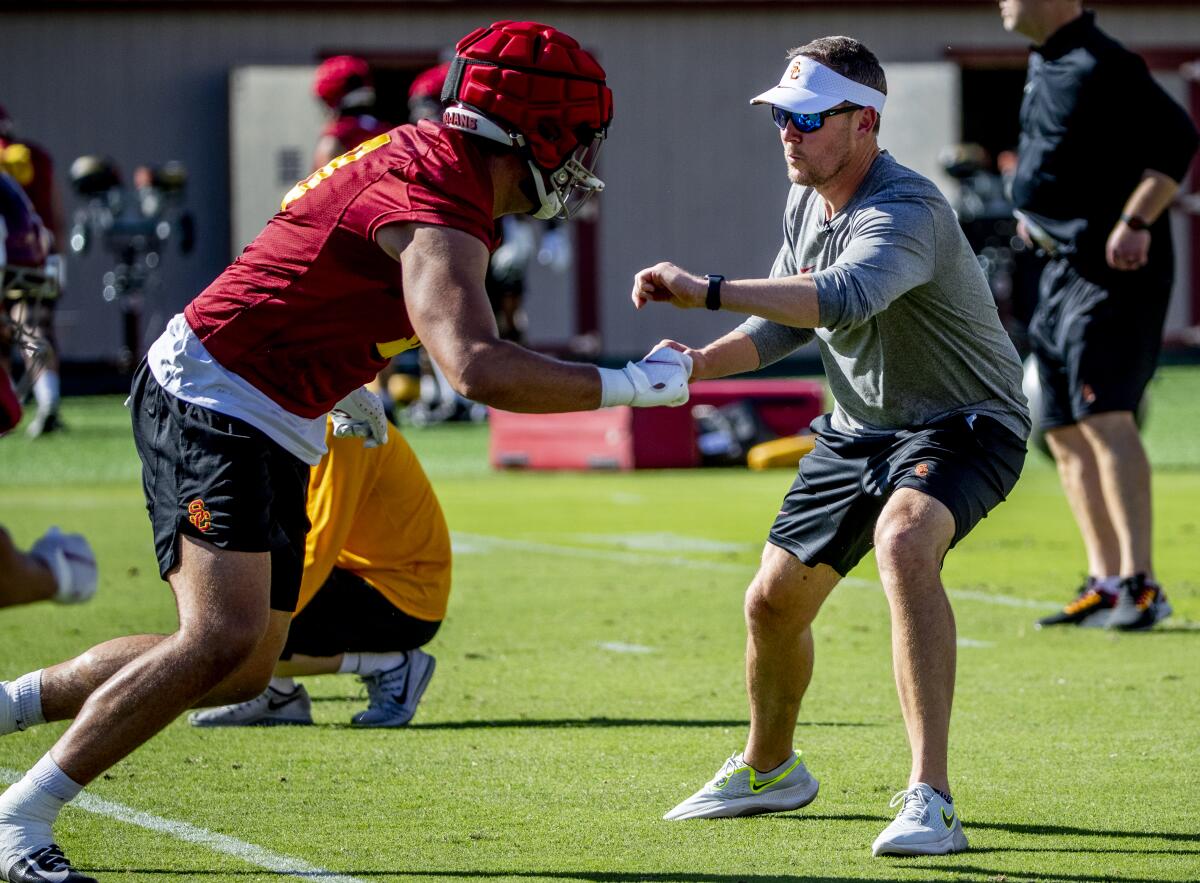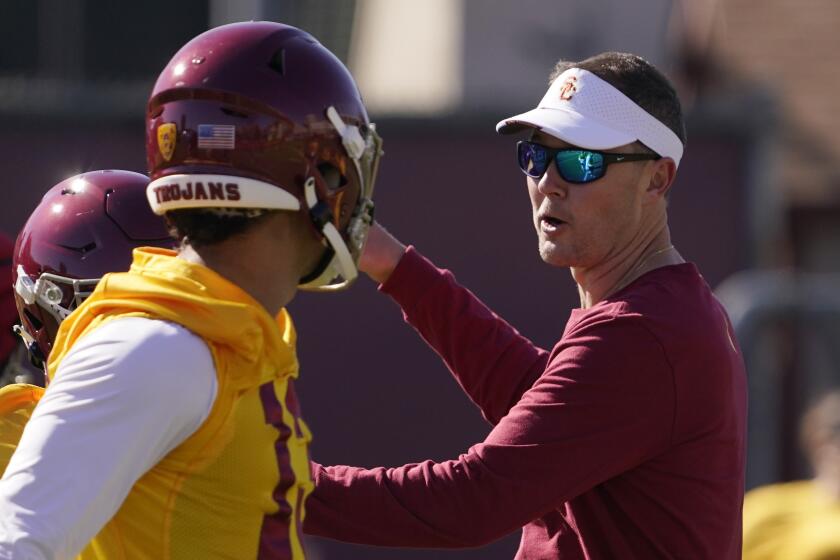USC tight end Jude Wolfe ready to make an impact, at last, in Lincoln Riley’s offense

- Share via
Since he signed with USC in 2019 as one of the nation’s top tight end prospects, Jude Wolfe has been a forgotten man at a largely forgotten position.
“It hasn’t been everything I expected,” Wolfe said this week.
But after three seasons of being overlooked and underused, USC’s tight ends are finally expected to play a pivotal part in Lincoln Riley’s offense, and Wolfe, in the emerging role of H-back, could very well be its linchpin.
Integrating an H-back isn’t by any means an innovative offensive concept. Its roots date to the 1980s NFL, when Washington coach Joe Gibbs won three Super Bowls while regularly deploying two tight ends on his offense, one of which would offset from the line of scrimmage as the designated H-back.
The position has evolved plenty since, amid the advent of the spread offense. But Riley’s system takes that position several steps further, using it as a hybrid puzzle piece meant to unlock whatever the offense might need in any given moment. Its value, the coach explains, is in its versatility.
“It’s a great position,” Riley said. “It’s a position we’ve used probably as uniquely as anybody in the college football over the last several years.”
Under new coach Lincoln Riley, USC should attract a large crowd and TV audience to its spring game. UCLA to treat its game as a glorified workout.
Wolfe and his fellow tight ends have felt that unique usage firsthand this spring. Each has cross-trained in multiple spots, not only lining up as the H-back, but also working in the slot, split out wide and in-line.
Few positions require a more complex understanding of USC’s new system.
“You have to know the whole thing,” tight ends coach Zach Hanson said.
While he’s trained elsewhere, Wolfe has worked primarily at H-back this spring. In that time, he’s gotten a sense of how important the position could be for USC this season.
“I wouldn’t say it’s like the focal point of the offense by any means, but it certainly holds a lot more weight than it did in the past,” Wolfe said. “I think it’s much more crucial to how the offense functions.”
What that ultimately means in terms of production remains to be seen. But historically, the H-back has played a prominent part in Riley’s offense. Last season, Oklahoma’s lead H-back, Jeremiah Hall, caught 32 passes for 334 yards. Over three years, he scored 12 touchdowns in that role, third-most on the team during that stretch.

Hall was more of a bruising blocker type, at 6-2, 248 pounds. Wolfe, who is four inches taller, is more of a prototype tight end.
“We’ve had a lot of different skillsets in the past,” Riley said. “We’ve got some really intriguing skillsets here and it’s one you can just tailor it to do so, so many things with. It’s probably the most versatile position on the field.”
Swing lineman no more?
His role as the sixth man along USC’s offensive line earned him plenty of plaudits over the past three seasons. But it wasn’t until this spring, at the start of his fifth, that Justin Dedich finally received an extended look as an entrenched starter.
He’s taken advantage of the opportunity. On Tuesday, USC offensive line coach Josh Henson called Dedich “our most consistent performer through spring.”
But will he continue as USC’s starting right guard into the fall?
That depends, in large part, on the domino effect of transfer offensive tackle Bobby Haskins’ healthy return. Haskins is expected to seize the left tackle spot in the fall, displacing sophomore Courtland Ford, who would compete with Jonah Monheim at right tackle. If Ford wins the job, Monheim could potentially shift inside, displacing Dedich.
Lincoln Riley’s experience at Oklahoma suggests USC may run the ball far more often than a traditional Air Raid offensive attack.
But the spring has given Dedich an extended audition at right guard. If that doesn’t stick, the fifth-year senior has no problem bouncing around the line again as a reserve.
“Kind of been my motto through my career here, be where I’m needed and where I’m called upon,” Dedich said.
Spring game notes
In lieu of splitting into two full teams, USC’s spring game will pit its offense against its defense, with a special scoring system that Riley used in the past when Oklahoma faced similar depth issues. “We don’t quite have enough bodies to go into two full squads,” Riley said. … The two halves of the Trojans roster will play a single half of football. Riley said he plans to let the two sides play on organically, as opposed to engineering specific situational football, like red-zone or goal-line situations.
More to Read
Go beyond the scoreboard
Get the latest on L.A.'s teams in the daily Sports Report newsletter.
You may occasionally receive promotional content from the Los Angeles Times.









